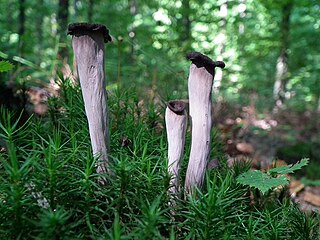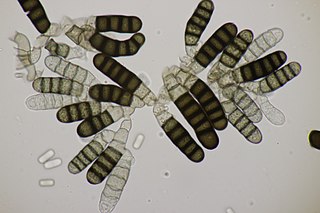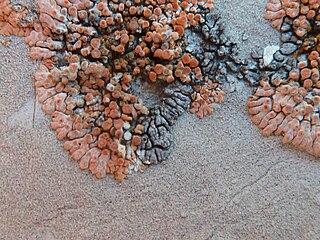
Mycology is the branch of biology concerned with the study of fungi, including their genetic and biochemical properties, their taxonomy and their use to humans, including as a source for tinder, traditional medicine, food, and entheogens, as well as their dangers, such as toxicity or infection.

Craterellus is a genus of generally edible fungi similar to the closely related chanterelles, with some new species recently moved from the latter to the former. Both groups lack true gills on the underside of their caps, though they often have gill-like wrinkles and ridges.

Nectria is a genus of Ascomycete fungi. They are most often encountered as saprophytes on decaying wood but some species can also occur as parasites of trees, especially fruit trees and a number of other hardwood trees. Some species are significant pests causing diseases such as apple canker, Nectria twig blight, and coral spot in orchards.

Thielaviopsis is a small genus of fungi in the order Microascales, and family Ceratocystidaceae. The genus includes several important agricultural based pathogens. The most widespread is T. basicola, the causal agent in several root rot diseases of economically important crop species including cotton and a variety of vegetables. In cotton, Thielaviopsis causes root rot, also known as black root rot, which causes necrosis of the roots and stunting of the crop plants.

Metrosideros polymorpha, the ʻōhiʻa lehua, is a species of flowering evergreen tree in the myrtle family, Myrtaceae, that is endemic to the six largest islands of Hawaiʻi. It is a highly variable tree, being 20–25 m (66–82 ft) tall in favorable situations, and a much smaller prostrate shrub when growing in boggy soils or directly on basalt. It produces a brilliant display of flowers, made up of a mass of stamens, which can range from fiery red to yellow. Many native Hawaiian traditions refer to the tree and the forests it forms as sacred to Pele, the volcano goddess, and to Laka, the goddess of hula. ʻŌhiʻa trees grow easily on lava, and are usually the first plants to grow on new lava flows.

Ceratocystis fimbriata is a fungus and a plant pathogen, attacking such diverse plants as the sweet potato and the tapping panels of the Para rubber tree. It is a diverse species that attacks a wide variety of annual and perennial plants. There are several host-specialized strains, some of which, such as Ceratocystis platani that attacks plane trees, are now described as distinct species.

The Xenasmataceae are a family of crust fungi in the order Polyporales. The family was circumscribed in 1966 by German mycologist Franz Oberwinkler with Xenasma as the type genus. As of April 2018, Index Fungorum accepts 28 species in the family. Xenasmataceae fungi grow as saprobes on fallen wood and are known primarily from temperate areas.
Morenoina is a genus of fungi in the Asterinaceae family. The relationship of this taxon to other taxa within the class is unknown, and it has not yet been placed with certainty into any order.

Lanzia is a genus of fungi within the family Rutstroemiaceae.
Arthopyrenia is a genus of fungi within the Arthopyreniaceae family. The genus has a widespread distribution, and contains about 117 species.

The Ophiostomataceae are a family of fungi in the Ascomycota, class Sordariomycetes. The family was circumscribed by J.A. Nannfeldt in 1932. Species in the family have a widespread distribution, and are typically found in temperate regions, as pathogens of both coniferous and deciduous trees.
Limacinula is a genus of fungi within the Coccodiniaceae family. The genus was first named by Franz Xaver Rudolf von Höhnel in 1907.
Payosphaeria is a genus of fungi in the Hypocreales order. The relationship of this taxon to other taxa within the order is unknown, and it has not yet been placed with certainty into any family. This is a monotypic genus, containing the single species Payosphaeria minuta.

The corticioid fungi are a group of fungi in the Basidiomycota typically having effused, smooth basidiocarps that are formed on the undersides of dead tree trunks or branches. They are sometimes colloquially called crust fungi or patch fungi. Originally such fungi were referred to the genus Corticium and subsequently to the family Corticiaceae, but it is now known that all corticioid species are not necessarily closely related. The fact that they look similar is an example of convergent evolution. Since they are often studied as a group, it is convenient to retain the informal (non-taxonomic) name of "corticioid fungi" and this term is frequently used in research papers and other texts.
Lasiodothiorella is a genus of fungi in the family Botryosphaeriaceae. There are 15 species.
The Ceratocystidaceae are a family of fungi in the class Sordariomycetes, subclass Hypocreomycetidae.
Ceratocystis cacaofunesta is an ascomycete fungus that causes a wilt disease in cacao trees. It has led to significant economic losses in Latin America.
Ceratocystis oblonga is a plant-pathogenic saprobic fungal species first found in Africa, infecting Acacia mearnsii and Eucalyptus species.

Rapid ʻŌhiʻa Death (ROD) is a fungal disease that is rapidly killing forests of ʻōhiʻa —an ecologically important native tree species within the Hawaiian Islands that has provided a plethora of habitats for endangered birds and other species. Initially reported by landowners in Puna in 2010, ROD spread quickly across tens of thousands of acres of ʻŌhiʻa trees on the Hawaiian Islands. To date, hundreds of thousands of these trees have died from this fungal disease alone. Previously healthy Ōhiʻa trees have been observed to die within a few days to weeks, which is why the disease is known as "Rapid Ōhiʻa Death".

Verrucula is a genus of lichenicolous (lichen-dwelling) lichens in the family Verrucariaceae. Species in the genus are parasitic on saxicolous (rock-dwelling), crustose lichens, including Xanthoria elegans as well as lichens from genus Caloplaca that contain chemical substances called anthraquinones.











